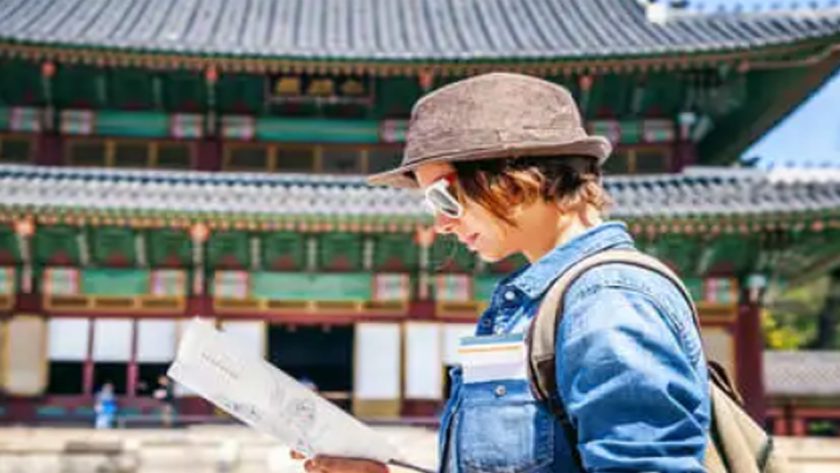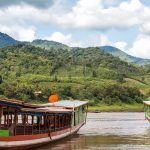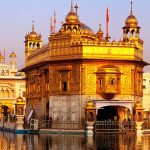Pulguksa Temple, Kyungju, South Korea
Legend has it that, when the sun rises in the East, Pulguksa Temple on the slopes of Mount T’ohamsan is the first place to feel its rays.
It is also said that this mystical peak, arching out of South Korea’s craggy coastline, will inspire utmost serenity and relaxation in all whom experience its wonder.
I wasn’t so sure.
After days of traveling along the windy, congested, and often dangerous highways and byways of the southern tip of the Korean peninsula, I found myself wishing for the mundane pleasures of home. The frenetic intensity of the journey to the nearby town of Kyungju, coupled with the immense heat that is unmistakably Asian, had me weary and dog-tired, and hiking to the top of Mount T’ohamsan was seeming more like a chore than an opportunity for spiritual enlightenment.
Built around the middle of the sixth century A.D., Pulguksa Temple is a winged, arched and geometrically precise architectural example of Buddhism at its finest; sturdy beams and sweeping rooftops, simple courtyards and the finest detailed woodwork, all balanced at the top of a mountain.
After reaching the final plateau before the mount’s summit, I was greeted by the giant stone bell of King Songdok the Great. Songdok was one of the land’s rulers in 1300 A.D., Korea’s heyday when the entire peninsula was united under three kingdoms.
The bell is a brooding sentinel from another world, ushering visitors away from the hustle of life on the surface and into the ether world that occupies the zenith. At this point, I began the mile-long trek to the top of the mountain, stepping through refreshing green patches of primordial forest. The temperature is several degrees cooler, and the forest pushes you along with a gentle, lifelike urgency.
Over the course of this “miracle” mile, my frustration and irritation gradually, then completely, vanished, replaced instead by a sense of awe and wonder. Each turn in the thick foliage brought excitement. Would the temple be around the corner? Is the temple near? Knowing the temple was designated one of UNESCO’s World Heritage Sites, I figured that disappointment was not going to be an option.
The approach to the temple is relatively unspectacular, and feels strangely familiar. The first view of the temple is an unassuming wooden structure, roughly ten feet high and built against the brown stone cliff beyond. The traditional Korean architecture is evident in the swooping, curving archways in the temple’s entrance and exit. Beside the temple is the lone element of kitsch in the whole experience: well-wishers can purchase tiles (bearing their name, address, and date of visit) to be used in the perpetual maintenance of the temple. Whatever pays the bills that awesome spiritualism costs these days, I suppose.
Sokkuram, part of the Pulguksa temple complex, is where the Buddha resides. I entered the smallish temple expecting more of the same fare that I’d experienced during my weeklong visit to this striking nation: a delicate, reverent monument to Buddha, a figure familiar around the world, sitting in the lotus position and keeping close watch over his subjects.
What I got was goosebumps.
It took me several moments to get my bearings inside the structure. I had clearly been deceived. The temple was not small at all; the wooden structure in front was merely a facade for the enormous, sprawling temple carved into the mountain itself. Its roof was about a hundred feet high.
The Sokkuram Buddha itself was inspiring. The imposing statue towered fifty feet high – the head itself was over eight feet tall. It was seated in the pose I’d expected, but the sheer immensity and cavernous surroundings completely floored me. I’m not Buddhist, but my spirit was touched that moment, I can assure you.
In the center of Buddha’s forehead is a large diamond. Apparently the original diamond was one of the largest precious stones in the world, in its day, but was destroyed by Japanese soldiers during World War II. Its replacement is more than sufficient.
When I’d paid the Buddha sufficient homage, I emerged from the temple. In my reverence and surprise I’d completely ignored Pulguksa’s surroundings. From the mountaintop, miles and miles of verdant green forests and valleys stretched as far as the eye could see. A refreshing, cloudy mist had floated across the valley during my time inside, and its sprays deepened the soothing sensation of being atop Mount T’ohamsan.
I returned to the plateau and Songdok’s bell, accompanied by the rhythmic, piped-in chants of ancient Eastern mystics. The scratchy, crackling speakers playing the traditional musics was a cheesy touch, but in the moment, it perfectly complemented the scene. Descending from the South Korean mountain, I felt different. I felt clear-headed, relaxed, refreshed. I guess that’s what taking a hike to heaven can do.




buy androxal cheap online no prescription
how to order androxal buy online australia
get enclomiphene generic available in united states
how to buy enclomiphene buy from canada
discount rifaximin without a script
buying rifaximin cheap generic uk
how to order staxyn cheap from india
discount staxyn generic canadian
order avodart purchase toronto
buying avodart usa drugstore
commande sans ordonnance kamagra
acheter kamagra low cost
order flexeril cyclobenzaprine cheap canada pharmacy
ordering flexeril cyclobenzaprine price canada
buy cheap dutasteride buy virginia
brand dutasteride
buying gabapentin without a script
ordering gabapentin cheap trusted
canada drugscom fildena
discount fildena generic version
buying xifaxan uk over the counter
get xifaxan without rx online
kamagra prášky kanadské lékárny objednávky
koupě kamagra bez rx